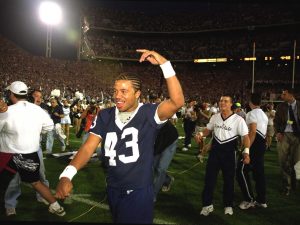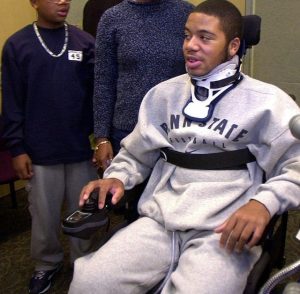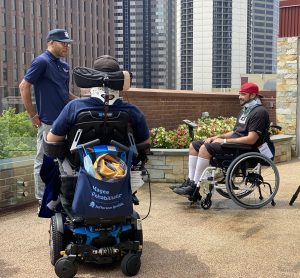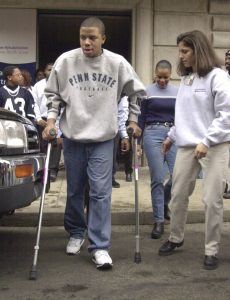
When many people hear the name “Adam Taliaferro,” they still think back to an ill-fated football game more than two decades ago, in which the Penn State cornerback was paralyzed while making a tackle. More importantly, people remember his miraculous recovery.
Adam was taken off the field in a stretcher. Doctors didn’t think he would walk again. Adam underwent intensive inpatient and outpatient rehabilitation at Magee. Always a fierce athlete, Adam approached his recovery with laser focus and relentless dedication. Nearly one year later, he stunned 110,000 Penn State football fans when he donned his football jersey and led the team out onto the field at Beaver Stadium for the season opener.
That feat paved the way for a life helping others to overcome adversity. We caught up with Adam to talk about his 20+ year journey following his spinal cord injury.
Q: Why do you think leading the football team back on to the field one year later is still impactful for people?
That moment was what I call a “culmination of positivity.” A lot of people saw me get injured with their own eyes as they were sitting in the stands or watching TV. The prognosis was very bleak. In the days and months that followed, a lot of people prayed for me. They sent me cards and messages. When I came back a year later, it was important for me to show everyone I was going to be okay and to thank them for all of the support. It also provided me with some closure on that chapter of my life.
 Q: What was the point that you realized your life was going to be different than what you had imagined?
Q: What was the point that you realized your life was going to be different than what you had imagined?
When I first got to Magee and I looked around, I saw all of the patients fighting to recover from their injuries and illnesses. That’s when I started to accept the impact this was going to have on my life. My dream was to play professional football and that was no longer a reality. My biggest goal during my recovery at Magee was being able to walk out of that tunnel at Beaver Stadium. After that day, it was time to focus on what to do next. I sat down with an academic advisor to help me focus my interests and options. After hours of conversations with my parents, I decided I wanted to go into law. The next three to four years were all about academics and preparing for law school.
Q: Over the years you have mentored many individuals with spinal cord injuries. What kind of advice do you give others facing that same realization?
Everybody responds differently. Some people it may take a month. It may take two months. It may take a year for someone to realize how different their life is going to be. I always say we’re part of a special fraternity. None of us want to be in it, but we’re all here to support one another. Everyone recovers physically and mentally within their own timeframe.
I always tell people the definition of success is not walking. The definition of success is getting better than where you were when you first got the injury. That’s the most important thing.
Q: What is life like for you today?
 I’m just so thankful. I have two kids now. I’m married and I have a great job. I serve as the director of Strategic Alliances at Bristol Myers Squibb. I look at my kids running around, one of things I can’t do, and it brings a smile to my face. They’re our legacy. Making sure they’re happy and taken care of is my most important job these days.
I’m just so thankful. I have two kids now. I’m married and I have a great job. I serve as the director of Strategic Alliances at Bristol Myers Squibb. I look at my kids running around, one of things I can’t do, and it brings a smile to my face. They’re our legacy. Making sure they’re happy and taken care of is my most important job these days.
We have a nonprofit foundation where we partner with Magee to help newly injured patients and provide them with hope and assistance with their lives, both emotionally and financially. My high school football coach originally started The Adam Taliaferro Foundation 21 years ago to help with financial support because initially it was believed I would be in a wheelchair the rest of my life. Thankfully I didn’t need all those funds that were raised. I realized a lot of people aren’t as fortunate.
Our foundation provides funding to individuals who have spinal cord or any other catastrophic injury to help them with their needs that insurance may not cover. A main objective of the foundation is to provide resources and support to help patients get back to living their lives. Financial is a huge component, but there is also the emotional side. My biggest role is to be there to talk to the patients and their families, sharing my story and helping them come up with ways to get through this challenging time. My parents talk to their parents. It’s a way to give back, because I was given so much.
 Q: What do you hope your children learn from what you’ve gone through?
Q: What do you hope your children learn from what you’ve gone through?
The ability to overcome adversity, but you can’t do it all on your own sometimes. It’s okay to ask Mom and Dad and other people for help. That’s what we are all here for. If you’re able to do that you can get through tough times in life. It wasn’t until after my injury that I realized that you may need to lean on people to get through life. I have two great parents and a brother who were always there to help me.
Q: Has the adversity you experienced with your spinal cord injury helped you conquer other challenges since then?
There’s not a day that goes by that I don’t think back to my injury and the lessons that I learned through it. It’s helped me be the person that I am today. It helps us realize that inner drive that none of us knew that we had prior to going through this. Life’s adversities are not meant to paralyze you, they’re there to help you understand who you are. In my case, it literally paralyzed me, but it helped me better understand who I was and prepared me for life.




